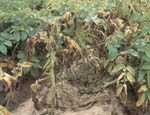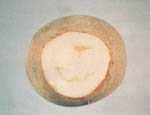
The fungi, Verticillium albo-atrum and V. dahliae, overwinter in infected tubers and in the soil in diseased plant debris. Plants become diseased early in the season either due to the planting of infected tubers or because of attack by the organism present in the soil. Verticillium wilt is often confused with other wilts and early maturity diseases (some are non-infectious, eg. drought). It is also referred to as early dying disease. Early death of leaves and stems on plants begins about flowering time and in irregular patches in the field, particularly on well drained sandy soils. Typically only one stem or one side of a stem will show wilting, especially during hot windy days or dry soil conditions. Wilted stems cut at soil level show brown vascular discolourations. Leaves become yellow, then brown, normally first at the bottom of the plant and then proceeding up the stem. As the whole crop matures, wilted plants may not be easily distinguished from naturally senescing plants.

